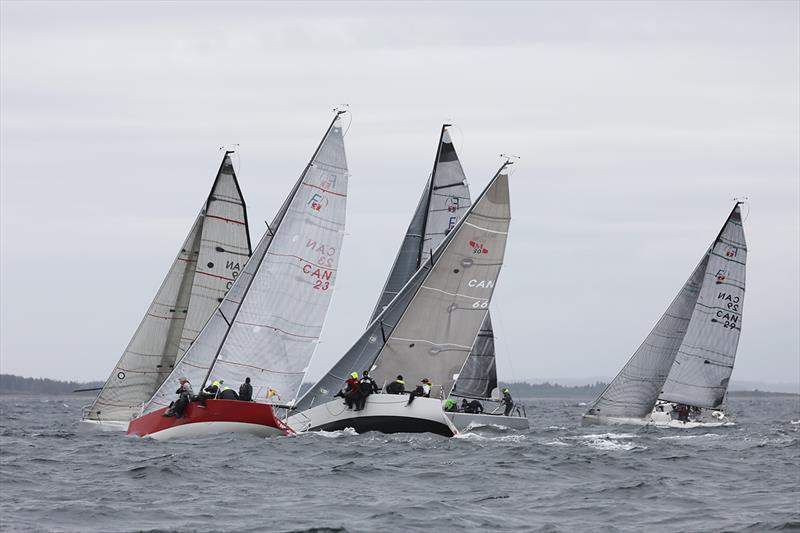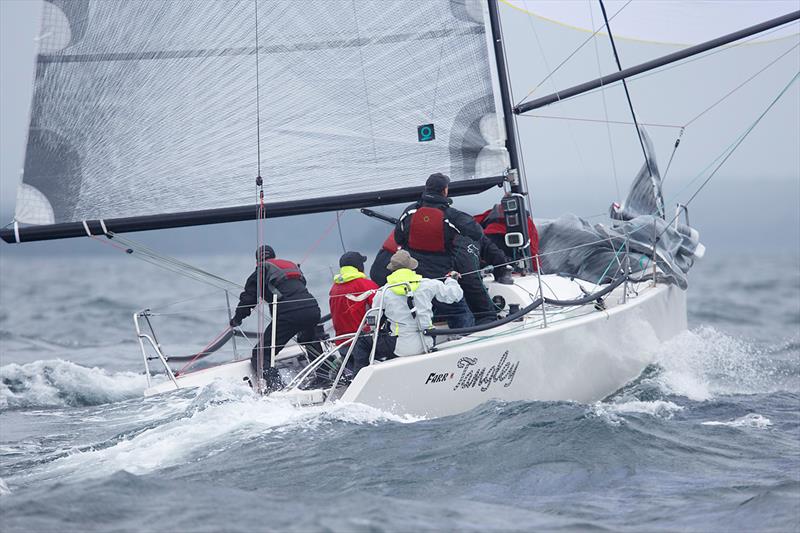
Darren Burns and Brian Todd about Farr 30s and the 2018 Helly Hansen Chester Race Week
by David Schmidt 14 Aug 2018 01:00 AEST
August 15-18, 2018

Farr 30 fleet-racing action at the 2017 Chester Race Week © 2017 Tim Wilkes /
www.timwilkes.com
When the Farr 30 was first introduced in 1995, it was a jaw-dropping new One Design fresh off the drawing boards of one of the world's premiere yacht-design houses, and it quickly attracted the attention of many of the world's best One Design sailors with its pleasing aesthetics and performance-sailing characteristics. Originally dubbed the Mumm 30 (until 2007, when sponsorship dried up), the first boats were built by Carrol Marine, and the class' first World Championship regatta unfurled on the waters off of Marseille, France, in 1997, with successive world-championship regattas taking place each year (with the exception of 2009, when racing was cancelled) through 2015, when the class held its last Worlds, which were contested off of Seattle, Washington.
Then, this past spring, the class took the unusual path of rescinding their international status in order to maintain the health of the class, especially for the class' increasingly Corinthian owners who are more interested in great racing than in levying massive war chests just to compete.
Roughly 200 of these capable One Design speedsters were built in the past 23 years, making these boats affordable acquisitions for teams looking to improve their high-performance game before stepping onto more contemporary designs and also helping committed and dedicated Farr 30 teams enjoy great racing sans the sort of gamesmanship (read: professional coaches, constantly improving sail wardrobes and international travel expenses) that is common with cutting-edge designs.
While dropping the class' international status means that the class can no longer hold a world championship regatta, the flipside for more Corinthian-oriented sailors is a class that promises stability and great racing, especially in North America, where the class is still free to participate in events such as the 2018 Helly Hansen Chester Race Week (www.chesterraceweek.com), which will take place on the waters off of Chester, Nova Scotia, Canada from August 15-18.
I interviewed Darren Burns, president of the Farr 30 World Council, and Brian Todd, co-principal race officer and One Design race officer for the Helly Hansen Chester Race Week 2018, to learn more about the class' recent evolutions.
Can you give us an update on the health of the Farr 30 class? Are you seeing growth, stability or a decline in the number of participating boats and sailors? Also, does this vary by country/region? What about in Canada and the USA?
DB: I would say the health of the class is stable. We have several pockets where strong fleets have assembled: Pacific Northwest, Canadian East Coast, U.S. North East, Northern Europe, and the Middle East. Our strongest area of growth is on the Canadian East Coast.
Helly Hansen Chester Race Week is well known all over North America for consistently high numbers of boats, great racing conditions in a beautiful setting, and being very well run and fun-so it gives us the best chance of attracting the largest number of Farr 30s.
How would you compare competition levels now compared to when the first Farr 30s were launched in the mid-90s?
DB: The competition level is still very high with extremely tight racing. All the national and international events still include top boats with professional sailors. The stronger the fleet numbers in a particular area, the closer the racing becomes.
It sounds like the majority of the boats competing in this year's Chester Race Week are coming from New England, Ontario, Quebec and the Canadian Maritimes—is it fair to say that the North American class is largely East Coast-based at this point? Also, can you tell us about the class culture? Are we talking about trailers, trucks/vans and tents/home stays, or are we talking about chartered boats, brand-new sails, hotel rooms, and professional sailors and coach boats?
DB: It's fair to say that the class has become regionally focused in the main regions I mentioned earlier. As new boat designs emerge, the Grand Prix teams and owners move on to the latest-production 30-footers.
We are still seeing a mix of fleet events where teams are competing at the highest-possible level. So I would say that the fleet is still in transition internationally.
All events over the last five years have included many boats with the full preparation to win, although I have not seen many coach boats in the last few [years].
I understand that the class recently rescinded their World Sailing One Design status-how has this change been playing out in terms of registration/participation numbers for the 2018 season?
DB: Overall, it hasn't affected our participation levels. Our decision to bow out as a One Design keelboat class had nothing do with our fleet strength but was the result of ISAF's 20-boat minimum for World events.
As Grand Prix owners, their money and crews migrated from Farr 30s to new designs over the years it has become cost-prohibitive for remaining Corinthian competitors to travel from coast to coast or from continent to continent to meet the minimums. That's nothing new.
But regional, national and continental Farr 30 One Design racing is very healthy with established fleets of ten to 12 [boats] and growing fleets of six to eight boats in the regions [mentioned] above.
Why? Because [the Farr 30] has staying power due to its exceptional design and enduring competitiveness. As the boats transition from a pure One Design class to a mix of regional PHRF and One Design racing, it continues to prove itself a dominant boat in mixed-fleet racing, particularly in light air.
For example, in a recent tune-up race on a friend's new C&C 30, we assembled a crew with two Olympic sailors and we could not beat the Corinthian-sailed Farr 30. The Farr 30 will continue to thrive and grow in key regions were crews want competitive 30-foot One Design racing without having to own a Fortune 500 company to fund it.
What kinds of on-the-water conditions can sailors expect in Chester in mid-August?
BT: Sailing in Mahone Bay off Chester in August is an experience every sailor should have at least once in their sailing life.
The waters are pristine, the wind comes in every day around noon and builds to a 12-18 knot sea breeze, the current effect is negligible and the temperature is usually around 21 to 24 degrees C [Editor's Note: 70-75 degrees Fahrenheit]. Once the breeze settles in there are minor oscillations to make the racing interesting.
Can you please tell us about any steps that the regatta has taken to "green-up" or otherwise reduce its environmental footprint?
BT: In 2016, Chester Yacht Club worked with Sailor's for the Sea, operators of the world's only certification program for sustainable water-based events, and achieved a bronze-level certification for Chester Race Week which it has maintained since.
To get to this bronze-level certification, we worked on event, venue, and food and beverage management, and public engagement. Central to our success was the creation of a Green Team that invited the community to help with the sustainability challenge.
Our actions and results include:
We moved to online regatta management system to reduce paper consumption and increase result-posting speed and accuracy to mobile, web and club-based flat screen monitors.
We use 100% post-consumer recycled paper or FSC-certified paper, [and we] ensured all printouts were double-sided.
We provided water-bottle refilling stations to encourage use of reusable water containers and reduce plastic bottle waste.
By recycling, we diverted fifty percent of all waste from the local landfill.
By composting, we diverted all food scraps from the local landfill.
We used reusable bags for participant event documents, eliminating single-use bags.
We had multiple waste stations on site each with three bins labeled "recycling", "compost", and "landfill".
And we educated staff and participants on how, where and why to separate their waste materials.
 www.timwilkes.com"
www.timwilkes.com" />
Peter Toombs and his Tangley crew recently won the 2018 Farr 30 Canadian Nationals, which were held on the waters off of Prince Edward Island - photo © © 2017 Tim Wilkes /
www.timwilkes.com
If you were a gambling man, what teams would you be laying odds on to collect trophies come the awards ceremony?
BT: It's no surprise that the teams with the best-trained crews and best-prepared boats will threaten for the hardware in all classes and fleets.
That said, Peter Toombs from Charlottetown, Prince Edward Island, has a strong chance as he is fresh off winning the Canadian championships this past weekend at his home club.
Anything else that you'd like to add, for the record?
BT: Come to Helly Hansen Chester Race Week you will be rewarded with fun times, warm hospitality and great racing!
Many thanks to Tim Wilkes Photography for providing the imagery for this article. You can find more of Mr. Wilkes' work here: www.timwilkes.com